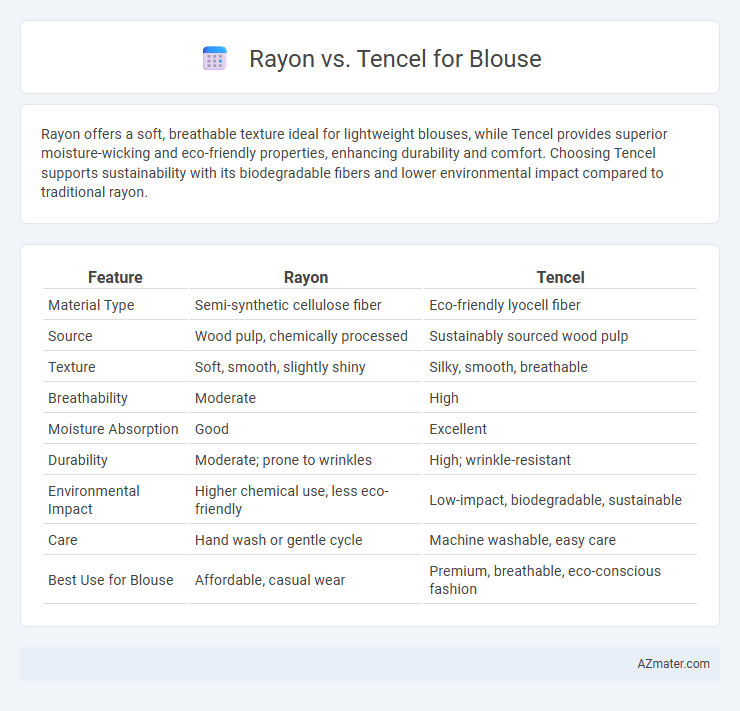Rayon offers a soft, breathable texture ideal for lightweight blouses, while Tencel provides superior moisture-wicking and eco-friendly properties, enhancing durability and comfort. Choosing Tencel supports sustainability with its biodegradable fibers and lower environmental impact compared to traditional rayon.
Table of Comparison
| Feature | Rayon | Tencel |
|---|---|---|
| Material Type | Semi-synthetic cellulose fiber | Eco-friendly lyocell fiber |
| Source | Wood pulp, chemically processed | Sustainably sourced wood pulp |
| Texture | Soft, smooth, slightly shiny | Silky, smooth, breathable |
| Breathability | Moderate | High |
| Moisture Absorption | Good | Excellent |
| Durability | Moderate; prone to wrinkles | High; wrinkle-resistant |
| Environmental Impact | Higher chemical use, less eco-friendly | Low-impact, biodegradable, sustainable |
| Care | Hand wash or gentle cycle | Machine washable, easy care |
| Best Use for Blouse | Affordable, casual wear | Premium, breathable, eco-conscious fashion |
Introduction to Rayon and Tencel Fabrics
Rayon, a semi-synthetic fiber made from regenerated cellulose, is well-known for its smooth texture and affordable price, making it a popular choice in blouse fabric. Tencel, a branded type of lyocell fiber derived from sustainably sourced wood pulp, offers superior breathability, moisture-wicking properties, and eco-friendliness compared to traditional rayon. Both fabrics provide a soft hand feel and drape, but Tencel stands out for its durability and environmentally responsible production process.
Fiber Origins and Manufacturing Processes
Rayon, derived from cellulose fibers such as wood pulp or cotton linters, undergoes a chemical-intensive production process involving the viscose method, which impacts its environmental footprint. Tencel is a branded lyocell fiber sourced from sustainably managed eucalyptus trees, manufactured using a closed-loop process that recycles solvents and minimizes waste. The key distinction lies in Tencel's eco-friendly production and renewable raw materials compared to rayon's conventional, resource-heavy methods.
Environmental Impact and Sustainability
Tencel, made from sustainably harvested eucalyptus trees using a closed-loop production process, offers a significantly lower environmental impact compared to traditional rayon, which relies on chemically intensive wood pulp processing and often causes water pollution. Tencel's biodegradable fibers require less water and energy during manufacturing, making it a more sustainable choice for blouses. The eco-friendly certification and reduced carbon footprint of Tencel contribute to its rising popularity in sustainable fashion over conventional rayon fabrics.
Texture, Feel, and Wearability
Rayon offers a smooth and silky texture that drapes elegantly, providing a lightweight and breathable feel ideal for blouses in warm weather. Tencel, derived from sustainably sourced wood pulp, features a soft, smooth surface with enhanced moisture-wicking properties and superior breathability, making it more comfortable for extended wear. Both fabrics are breathable, but Tencel generally outperforms Rayon in durability and eco-friendliness, offering a luxurious feel with less susceptibility to wrinkles and shrinkage.
Breathability and Moisture Management
Tencel fibers, derived from eucalyptus trees, offer superior breathability and moisture-wicking properties compared to traditional rayon, making Tencel blouses ideal for maintaining comfort in warm and humid conditions. Rayon, while soft and lightweight, tends to retain moisture and lacks the advanced moisture management capabilities of Tencel, often resulting in a less breathable fabric. The inherent structure of Tencel promotes rapid moisture evaporation and enhanced airflow, ensuring a cooler and drier wearing experience in blouses.
Durability and Longevity in Blouses
Rayon, a semi-synthetic fiber, tends to have moderate durability but can weaken when wet, making it less ideal for long-term blouse wear. Tencel, crafted from sustainably sourced wood pulp, offers superior tensile strength and resistance to wrinkles, contributing to enhanced longevity in blouses. Due to its moisture-wicking properties and durability, Tencel blouses maintain their shape and appearance longer than rayon counterparts.
Color Retention and Dyeing Qualities
Tencel fibers exhibit superior color retention and vibrant dyeing qualities compared to rayon, maintaining brilliance after multiple washes due to their smooth, non-porous surface that allows deeper and more uniform dye absorption. Rayon tends to fade quicker as its more porous structure absorbs dye unevenly, leading to less durability in color over time. The eco-friendly production process of Tencel also supports the use of reactive dyes, which enhance colorfastness and reduce environmental impact in blouse manufacturing.
Ease of Care and Maintenance
Rayon blouses require gentle hand washing or dry cleaning to prevent shrinking and maintain fabric integrity, with care instructions emphasizing minimal exposure to heat. Tencel blouses offer superior ease of care, often machine washable on gentle cycles and highly resistant to wrinkles and shrinking, reducing maintenance time. The moisture-wicking and breathable properties of Tencel further enhance durability and freshness, making it a practical choice for everyday wear.
Price Comparison and Availability
Rayon blouses typically offer a lower price point compared to Tencel, making them more accessible for budget-conscious shoppers. Tencel, derived from sustainably sourced eucalyptus fibers, tends to cost more due to its eco-friendly production process and higher durability. In terms of availability, rayon fabrics are widely found in retail stores and online marketplaces, whereas Tencel blouses are gaining popularity but remain less common and often priced at a premium.
Choosing the Right Fabric for Your Blouse
Rayon offers a soft, breathable texture ideal for lightweight blouses, while Tencel provides superior moisture-wicking and durability due to its eco-friendly lyocell fibers. Selecting the right fabric hinges on desired comfort, sustainability, and maintenance, with Tencel excelling in wrinkle resistance and environmental impact. For a blouse that balances softness and long-lasting wear, Tencel is often the preferred choice, especially for those prioritizing sustainable fashion.

Infographic: Rayon vs Tencel for Blouse
 azmater.com
azmater.com